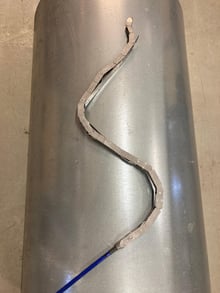
PEC Snake can pass through constrictions and sharp bends
Experts from TÜV Rheinland have developed a new probe for inspecting corrosion of the offshore oil and gas wells. The inspection tool features a caterpillar track design, is over 1 meter long and is as agile as a snake. Unlike all previous inspection probes, the "PEC Snake" can penetrate through a 2-inch hole or a 2-inch side valve arm. The highly flexible probe easily enters through sharp bends and can still be moved into tight spots on offshore platforms, such as between the conductor and the surface casing. "The inspection tool has successfully passed its field test in the North Sea and is now available for use on offshore oil and gas production platforms worldwide," said Sergey Putintsev, Managing Director at TÜV Rheinland. "The test results provide operators with important information about the degree of corrosion and the mechanical integrity of the offshore structure and help minimize the risk of well collapse."
PEC-Snake enables more accurate inspection results
The probe is equipped with a special "whisker" mechanism that serves as a positioning system to correctly position the miniaturized PEC sensors against the conductor and casing. The inspection is performed with pulsed eddy current (PEC) probes and is possible for both operating and abandoned wells. A 90-meter cable nearly doubles the operating range compared to other existing probes. The test results provide important information about the degree of corrosion and the mechanical integrity of the offshore structure, minimizing the risk of a well collapse. "The PEC snake is a major technical breakthrough that enables O&G operators to prevent fatal casing, conductor or entire well failure," said Riccardo Scottini, Product and Business Development Manager at TÜV Rheinland. "Thanks to the smaller access and longer probe cable, the new Sonovation device can be used in many types of offshore production operations around the world."
For cases where the well annulus between the conductor and the surface casing might be cemented or grouted, TÜV Rheinland experts use an improved version of the previously used C-PEC probe, which is ATEX certified. This probe has been further developed specifically for accessing the borehole annulus between the surface casing and the intermediate casing.
For more information and a video, visit www.tuv.com at TÜV Rheinland.


